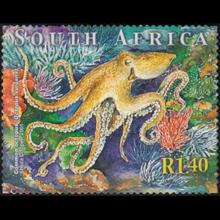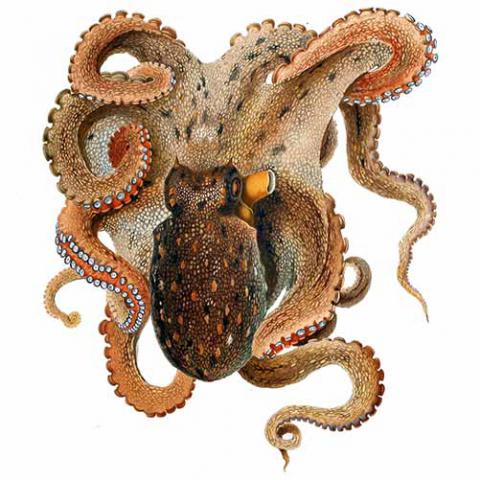NAMES
TAXONOMY
South Africa
Issued:
Stamp:
Octopus vulgaris
South Africa
Issued:
Stamp:
Octopus vulgaris
South Africa
Issued:
Stamp:
Octopus vulgaris
At first I was a little reluctant to watch this movie, but decided to take the recommendation of my girlfriend's sister. As it turned out, I'm glad I did. It is an inspiring documentary that changed me in a good way. As the title suggests, it's about a relationship between a human and an octopus. But enough said - check out the film clip. Although this species is found throughout the world, this particular octopus (from the film) lives in a kelp forest off the coast of South Africa (RSA), which is why I chose to highlight the stamp issued from that country. The stamp was issued in 2001 and the film released in 2020, so I doubt that the image portrayed on the stamp was of the one that starred in the documentary.
Genus species (Animalia): Octopus vulgaris
The common octopus (Octopus vulgaris) is a mollusc belonging to the class Cephalopoda. Octopus vulgaris is the most studied of all octopus species. It is considered cosmopolitan, that is, a global species, which ranges from the eastern Atlantic, extends from the Mediterranean Sea and the southern coast of England, to at least Senegal in Africa. It also occurs off the Azores, Canary Islands, and Cape Verde Islands. The species is also common in the Western Atlantic. The common octopus hunts at dusk. Crabs, crayfish, and bivalve molluscs (two-shelled, such as cockles) are preferred, although the octopus eats almost anything it can catch. It is able to change colour to blend in with its surroundings, and is able to jump upon any unwary prey that strays across its path. Using its beak, it is able to break into the shells of shelled molluscs. Training experiments have shown the common octopus can distinguish the brightness, size, shape, and horizontal or vertical orientation of objects.
Physiology
Circulation
The octopus has three hearts, one main two-chambered heart charged with sending oxygenated blood to the body and two smaller branchial hearts, one next to each set of gills. The circulatory circuit sends oxygenated blood from the gills to the atrium of the systemic heart, then to its ventricle which pumps this blood to the rest of the body. Deoxygenated blood from the body goes to the branchial hearts which pump the blood across the gills to oxygenate it, and then the blood flows back to the systemic atrium for the process to begin again. Three aortae leave the systemic heart, two minor ones (the abdominal aorta and the gonadal aorta) and one major one, the dorsal aorta which services most of the body. The octopus also has large blood sinuses around its gut and behind its eyes that function as reserves in times of physiologic stress.
The octopus' heart rate does not change significantly with exercise, though temporary cardiac arrest of the systemic heart can be induced by oxygen debt, almost any sudden stimulus, or mantle pressure during jet propulsion. Its only compensation for exertion is through an increase in stroke volume of up to three times by the systemic heart, which means it suffers an oxygen debt with almost any rapid movement. The octopus is, however, able to control how much oxygen it pulls out of the water with each breath using receptors on its gills, allowing it to keep its oxygen uptake constant over a range of oxygen pressures in the surrounding water. The three hearts are also temperature and oxygen dependent and the beat rhythm of the three hearts are generally in phase with the two branchial hearts beating together followed by the systemic heart. The Frank–Starling law also contributes to overall heart function, through contractility and stroke volume, since the total volume of blood vessels must be maintained, and must be kept relatively constant within the system for the heart to function properly.
The blood of the octopus is composed of copper-rich hemocyanin, which is less efficient than the iron-rich hemoglobin of vertebrates, thus does not increase oxygen affinity to the same degree. Oxygenated hemocyanin in the arteries binds to CO2, which is then released when the blood in the veins is deoxygenated. The release of CO2 into the blood causes it to acidify by forming carbonic acid. The Bohr effect explains that carbon dioxide concentrations affect the blood pH and the release or intake of oxygen. The Krebs cycle uses the oxygen from the blood to break down glucose in active tissues or muscles and releases carbon dioxide as a waste product, which leads to more oxygen being released. Oxygen released into the tissues or muscles creates deoxygenated blood, which returns to the gills in veins. The two brachial hearts of the octopus pump
Reference: Wikipedia


